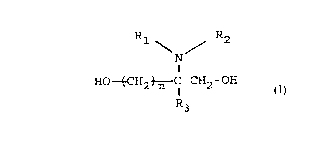Some of the information on this Web page has been provided by external sources. The Government of Canada is not responsible for the accuracy, reliability or currency of the information supplied by external sources. Users wishing to rely upon this information should consult directly with the source of the information. Content provided by external sources is not subject to official languages, privacy and accessibility requirements.
Any discrepancies in the text and image of the Claims and Abstract are due to differing posting times. Text of the Claims and Abstract are posted:
| (12) Patent: | (11) CA 2008589 |
|---|---|
| (54) English Title: | USE OF AMINODIOL AS AN ANTICORROSIVE FOR A VAPOR/CONDENSED WATER SYSTEM AND PROCESS FOR INHIBITING THE CORROSION OF SUCH A SYSTEM |
| (54) French Title: | EMPLOI D'AMINODIOL EN TANT QU'ANTICORROSIF POUR SYSTEME DE VAPEUR/EAU CONDENSEE ET PROCEDE D'INHIBITION DE CORROSION DANS UN TEL SYSTEME |
| Status: | Expired and beyond the Period of Reversal |
| (51) International Patent Classification (IPC): |
|
|---|---|
| (72) Inventors : |
|
| (73) Owners : |
|
| (71) Applicants : |
|
| (74) Agent: | ROBIC AGENCE PI S.E.C./ROBIC IP AGENCY LP |
| (74) Associate agent: | |
| (45) Issued: | 2000-08-29 |
| (22) Filed Date: | 1990-01-25 |
| (41) Open to Public Inspection: | 1990-08-09 |
| Examination requested: | 1996-02-26 |
| Availability of licence: | N/A |
| Dedicated to the Public: | N/A |
| (25) Language of filing: | English |
| Patent Cooperation Treaty (PCT): | No |
|---|
| (30) Application Priority Data: | ||||||
|---|---|---|---|---|---|---|
|
Disclosed is a process for inhibiting the corrosion
of vapor/condensed water system, which comprises adding to
boiler feed water an anticorrosive comprising 1-100% by weight
of at least one aminodiol general formula:
(see formula I)
wherein each of R1, R2 and R3 is selected from the group
consisting of each represents -H, -CH3, -C2H5 and -CH3; and n
represents an integer of 0 to 2, in an amount of 0.1 to 500 mg
per liter of said boiler feed water. The aminodiol, when added
to the boiler feed water, migrates into condensed water in
large quantities and inhibits corrosion of piping systems and
boilers in a highly effective manner.
Note: Claims are shown in the official language in which they were submitted.
Note: Descriptions are shown in the official language in which they were submitted.

2024-08-01:As part of the Next Generation Patents (NGP) transition, the Canadian Patents Database (CPD) now contains a more detailed Event History, which replicates the Event Log of our new back-office solution.
Please note that "Inactive:" events refers to events no longer in use in our new back-office solution.
For a clearer understanding of the status of the application/patent presented on this page, the site Disclaimer , as well as the definitions for Patent , Event History , Maintenance Fee and Payment History should be consulted.
| Description | Date |
|---|---|
| Time Limit for Reversal Expired | 2009-01-26 |
| Letter Sent | 2008-01-25 |
| Grant by Issuance | 2000-08-29 |
| Inactive: Cover page published | 2000-08-28 |
| Inactive: Final fee received | 2000-05-17 |
| Pre-grant | 2000-05-17 |
| Notice of Allowance is Issued | 2000-04-11 |
| Notice of Allowance is Issued | 2000-04-11 |
| Letter Sent | 2000-04-11 |
| Inactive: Status info is complete as of Log entry date | 2000-04-05 |
| Inactive: Application prosecuted on TS as of Log entry date | 2000-04-05 |
| Inactive: Approved for allowance (AFA) | 2000-03-28 |
| Inactive: CPC removed | 1998-07-06 |
| Inactive: IPC removed | 1998-07-06 |
| Inactive: First IPC assigned | 1998-07-06 |
| Request for Examination Requirements Determined Compliant | 1996-02-26 |
| All Requirements for Examination Determined Compliant | 1996-02-26 |
| Application Published (Open to Public Inspection) | 1990-08-09 |
There is no abandonment history.
The last payment was received on 1999-12-20
Note : If the full payment has not been received on or before the date indicated, a further fee may be required which may be one of the following
Please refer to the CIPO Patent Fees web page to see all current fee amounts.
| Fee Type | Anniversary Year | Due Date | Paid Date |
|---|---|---|---|
| MF (application, 8th anniv.) - standard | 08 | 1998-01-26 | 1998-01-07 |
| MF (application, 9th anniv.) - standard | 09 | 1999-01-25 | 1998-12-24 |
| MF (application, 10th anniv.) - standard | 10 | 2000-01-25 | 1999-12-20 |
| Final fee - standard | 2000-05-17 | ||
| MF (patent, 11th anniv.) - standard | 2001-01-25 | 2000-12-13 | |
| MF (patent, 12th anniv.) - standard | 2002-01-25 | 2001-12-13 | |
| MF (patent, 13th anniv.) - standard | 2003-01-27 | 2002-12-12 | |
| MF (patent, 14th anniv.) - standard | 2004-01-26 | 2003-12-19 | |
| MF (patent, 15th anniv.) - standard | 2005-01-25 | 2004-12-17 | |
| MF (patent, 16th anniv.) - standard | 2006-01-25 | 2005-12-12 | |
| MF (patent, 17th anniv.) - standard | 2007-01-25 | 2006-12-06 |
Note: Records showing the ownership history in alphabetical order.
| Current Owners on Record |
|---|
| KURITA WATER INDUSTRIES LTD. |
| Past Owners on Record |
|---|
| SHIRO TAYA |